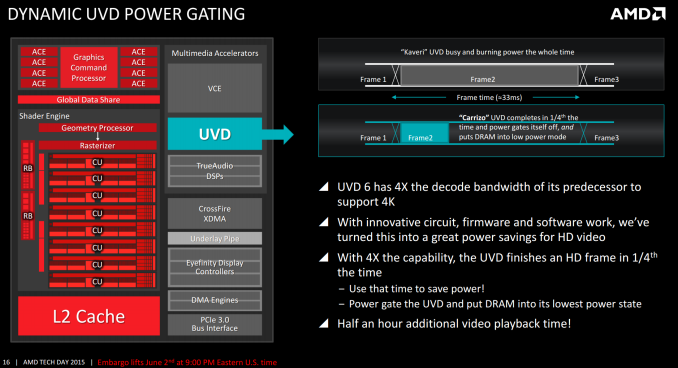AMD Launches Carrizo: The Laptop Leap of Efficiency and Architecture Updates
by Ian Cutress on June 2, 2015 9:00 PM ESTUnified Video Decoder and Playback Pathways
A typical consumer user experience revolves a lot around video, and AMD identified for Carrizo a big potential to decrease power consumption and increase performance in a couple of different ways. First up is adjusting the path by which data is moved around the system, particularly as not a lot of video matches up with the native resolution of the screen or is scaled 1:1.
When a video exhibits a form of scaling, either it is made full screen and scaled up or it is a higher resolution video that scales down, that scaling is typically performed by the GPU. The data leaves the decoder (either hardware or software), enters system memory, moves into the graphics memory, is processed by the GPU, moves back out to memory, and then is transferred to the display. This requires multiple read/write commands to memory, requires the GPU to be active but underutilized, and this happens for every frame. AMD’s solution to this is to provide some simple scaling IP in the display engine itself, allowing for scaled video to go from the decoder to the display engine, leaving the GPU in a low power state.
The video playback paths at the bottom of this side show the explanation graphically, and AMD is quoting a 4.8W down to 1.9W movement in power consumption for these tasks. Note that the 4.8W value is for Kaveri, so there are other enhancements in there is as well, but the overall picture is a positive one and AMD quotes a 500mW of APU power savings.
The Unified Video Decoder (UVD) has been built to support the above codecs, with HEVC decode on die as well as native 4K H.264 decode as well. I’ll come back to the 4K element in a second, but what is perhaps missing from this list is VP9, the codec used by Google for YouTube. YouTube is still the number one source for video content on the web, and as Google is transitioning more to VP9, as well as AMD’s competition advertising it as a perk on their latest hardware, it was perhaps confusing for AMD to miss it out. I did ask on this, and was told that they picked HEVC over VP9 as they believe it will be the more important codec going forward, particularly when you consider that the majority of the popular streaming services (NetFlix, Hulu, Amazon) will be using HEVC for their high definition titles.
Back onto the 4K equation, and this is possible because AMD has increased the decode bandwidth of the UVD from 1080p to 4K. This affords two opportunities – 4K video on the fly, or 1080p video decoded in a quarter of the time, allowing the race to sleep for both the UVD and DRAM. Despite a 75% reduction in work, as the UVD does not use that much power, it results in only 30 minutes of extra video playback time, but it is welcome and contributes to that often marketed ‘video playback’ number.













137 Comments
View All Comments
FlushedBubblyJock - Tuesday, June 9, 2015 - link
they probably have their contrast off, clear type disabled, the wrong screen font, smoothing edges of fonts disabled, then he's probably a far sighted coke bottled glasses with bifocals... thus amd must be had in dooper high rezz at 14fps...meacupla - Wednesday, June 3, 2015 - link
Ideally, what you'd get is a 2560x1440 screen with PROPER scaling to 1280x720, unlike what most monitors seem to do, which is a terrible job at scaling.SilthDraeth - Wednesday, June 3, 2015 - link
I run a Kaveri on my desktop and it drives 1080p just fine. Anyways, most intel laptops in that same range run 1366x768 screens also. At least almost every laptop you find in a Staples, or a Walmart. Very few of the devices on display have a higher resolution screen, or IPS solution.yankeeDDL - Wednesday, June 3, 2015 - link
Yes, *and* Intel's in that price range don't run games.FlushedBubblyJock - Tuesday, June 9, 2015 - link
yes they do make sure you have hd3000 at least but that's cheap as beansMargalus - Wednesday, June 3, 2015 - link
how is it an "issue that plagues AMD"? Are you saying AMD chips are buggy and crash at that resolution? Are you saying AMD graphics get corrupted at that resolution?medi03 - Thursday, June 4, 2015 - link
Ditto.In fact, 1366x768 TN (!!!) screen is the main issue with AMD mobile chips.
Drumsticks - Wednesday, June 3, 2015 - link
The 45W A8-6500T scores 71 in Cinebench R15. Even assuming that 15W kaveri gets identical performance (I couldn't think of a 15w kaveri chip to check on bench) that puts it at 106, which is finally, finally even with broad well in the xps 13, or at least <10%.Skylake will probably add another 10% gap, but this is the closest AMD might be in the last seven years or so to catching up with Intel. And at half the price, they could seriously have the start of a comeback!
xenol - Wednesday, June 3, 2015 - link
My only problem with AMD and the marketing blurbs is that they're targeting niche markets for all intents and purposes. Despite what PC gamers want us to think how big PC gaming is, it's not exactly a majority player in the entire scheme of things and gaming on a laptop isn't really that accepted.And even if gaming is involved, it's usually not games that require beefy specs to begin with.
Michael Bay - Wednesday, June 3, 2015 - link
PC gaming by marketshare is on par with any pastgen/nextgen console and sometimes more than one.